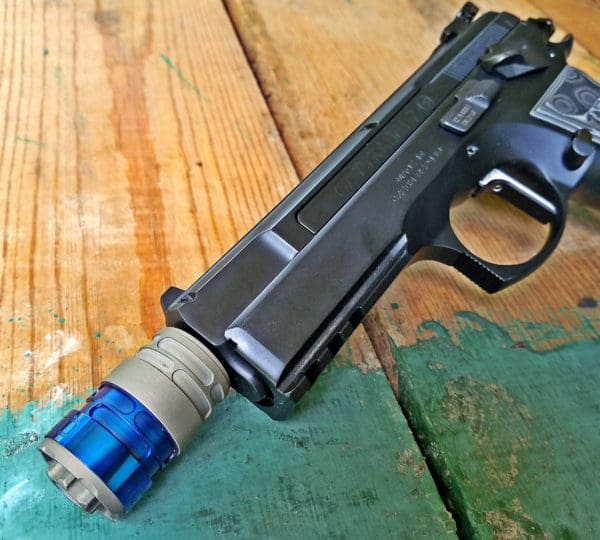
The only thing shorter than the ERECTOR silencer is the name of the company that makes it: Q. But it’s also the longest .22 LR suppressor on the market. And the lightest. And one of the quietest. But also one of the loudest. What? Better keep reading . . .
Fed up with the inertia of large corporations, a small group of silencer nerds jumped ship with Kevin Brittingham and started Q about a year ago. The goal? Innovate. Stab an EpiPen into the torpid evolution of silencers (and even firearms) and skip a few generations. Make not what people already want, but what they didn’t even know was possible.
Enter the Erector. This .22 LR suppressor — in stock at Silencer Shop as I type — is the most modular design ever available.
It exists as a 1/2-28 threaded aluminum mount with its affixed, stainless steel blast baffle. As seen in the lead photo, the front cap can be attached straight to it. But it also comes with another nine aluminum baffles. Each one can be added to the blast baffle, not unlike an Erector Set, as many or as few as you want, capped off with the front cap.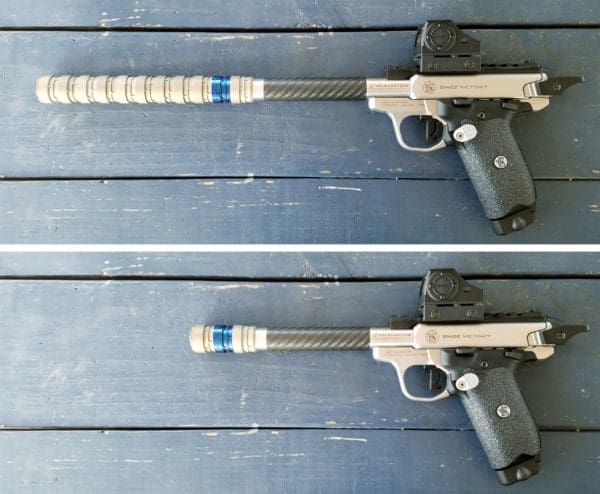
In this way the user can balance sound suppression with length and weight. For instance, a .22 LR rifle will need far less suppressor to achieve the same, comfortable volume level as a .22 LR pistol will. Or outdoor shooting vs. indoor shooting. Or aesthetics or maneuverability vs. ultimate sound reduction.
Perhaps the biggest surprise with the Erector is its weight, or lack there of. Each baffle weighs only 0.2 ounces according to my fine-measurement digital scale. The mount and blast baffle assembly is the heaviest component at 0.78 ounces and the front cap weighs in at 0.13.
So, despite looking really long and unwieldy in its all-nine-baffles-attached, 7.6″-long configuration, the Erector still weighs only 2.6-ish ounces. As far as I’m aware, that makes it the lightest (and longest) .22 LR suppressor on the market. In its largest configuration.
In its shortest config, the 1.75″-long Erector weighs a scant 0.91 ounces. It’s so tiny and so lightweight that it’s effectively unnoticeable. Yet, it does cut down on sound level by about 8 dB. While this isn’t enough to bring a typical .22 LR pistol into the hearing safe realm, it meters as hearing safe on a .22 LR rifle. Especially shooting subsonic ammo, where dB readings clock in around 132.
To lengthen your erection, simply remove the front cap, add as many baffles as desired, and replace the front cap. Photo dump of each additional configuration option:
Simply reverse the process to make your erection smaller again. Should you encounter any baffles stuck for more than four hours, seek immediate medical help. Or, just use the provided blue wrench clamp widgets for additional lefty loosey leverage.
Configured to the approximate length of my AAC Element 2, Q’s Erector weighs less than half (46.7%) as much. And the Element 2 is considered a lightweight can. And it is. Or was. The Erector simply moved the goalposts. Or dropkicked them.
At the shooter’s ear it’s just as quiet, too. It’s your well-designed .22 LR suppressor Hollywood-level thwack thwack. So hearing safe that, from behind the gun, the action is louder than the gunshot.
On a rifle I don’t think I got much, if any, utility in using more baffles.
In fact, it was shockingly quiet with just a single baffle. I’d gladly and comfortably plink all day long, sans unnecessary ear pro, with this setup.
A pistol, though, is a different story. With the shorter barrel the suppressor is doing much more work, cooling down hotter gasses under higher pressure.
Starting in a long configuration and working my way down, below that Element 2-ish length (five baffles added) the difference in volume level became obvious. Between five baffles and all nine was a noticeable jump, but seemed smaller than the jump from five to four. And four to three, etc.
Meanwhile, as the volume level went up I became increasingly impressed with the sound tone of the Erector. It remained extremely deep in tone, and the additional volume presented as a lower-pitched “whump” or “thump” rather than a “crack” like you’d expect from an unsuppressed .22 LR shot.
As seen in the video, I went all the way down to one baffle added. After all, I was informed it isn’t hearing safe on a pistol without at least one baffle. With some trepidation, I broke the trigger and found…it was still completely comfortable. Though without a dB meter I can’t truly be sure (Silencer Shop will be publishing full dB data on the Erector soon, which I’ll add here), I’m confident it was below the 140 dB impulse noise threshold. It seemed quieter to me than suppressed .300 BLK, for instance, and the echo off the canyon walls and such seemed quieter as well.
Q’s Erector is unlike anything else on the market. Somehow it manages to be both the longest and shortest .22 LR suppressor on the market; both [quite likely] the quietest and the loudest. Any way you build it, though, it remains the lightest.
Now, before Silencer Shop’s phone lines melt down, it’s important to note that the light weight comes with a trade-off. With the exception of the blast baffle, the Erector is all-aluminum. Thin aluminum, at that. The most powerful caliber it’s rated for is .22 LR, and it isn’t “full-auto rated.” The Erector isn’t that any-use rimfire can that also handles 5.7×28 and .17 HMR, harsh cleaning, etc. Q makes the El Camino for that.
My joy with the Erector is in its ability to be exactly as much suppressor as needed, and no more. Since this changes whether you’re shooting a pistol or a rifle, indoors or outdoors, with your kids (or a first time shooter) or without, so does the Erector. Even in its [almost comical] longest configuration, though, it’s so lightweight it’s difficult to even notice its presence on the end of a pistol or rifle. In its shorter configs, it’s just plain cool.
If nothing else, the Q Erector represents the next generation of modular silencers.
Specifications: ERECTOR by Q
Weight: From 0.91 ounces to 2.6 ounces
Length: From 1.75 inches to 7.6 inches
Diameter: 0.99 inches
Materials: stainless steel blast baffle, aluminum mount and baffles
Finish: Not specified (I believe PVD on the blast baffle and beat blast on the aluminum)
Caliber Rating: .22 LR (presumably .22 Short is also fine)
Full-Auto Rated: No
MSRP: $499 (~$450 on Silencer Shop)
Ratings (out of five stars):
Form Factor * * * * *
It’s all the forms in one, and super lightweight regardless.
Sound Performance * * * * *
It’s as quiet as any rimfire suppressor on the market. Or it’s not. Up to you.
Utility * * *
The Erector takes a hit on utility because of its caliber limitations, which are more restrictive than the norm. Additionally, aluminum baffles further hinder the owner’s suppressor cleaning options. The Erector makes up for these restrictions with its adjustable size and extremely light weight.
Overall * * * *
As someone’s second rimfire can, the Erector could easily be a five-star choice. As a first rimfire can, I simply can’t see recommending it over Q’s El Camino or similar suppressors. Nothing’s similar to the Erector, though. Shortest, longest, quietest, loudest…lightest. Awesome.



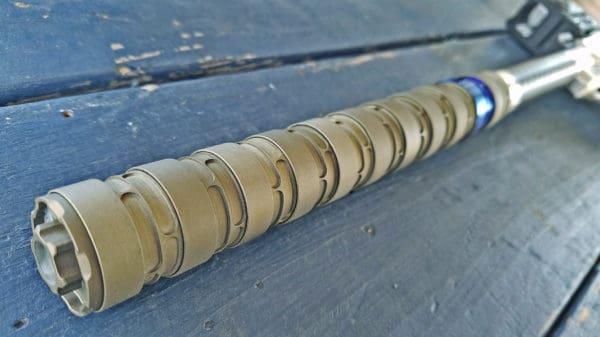
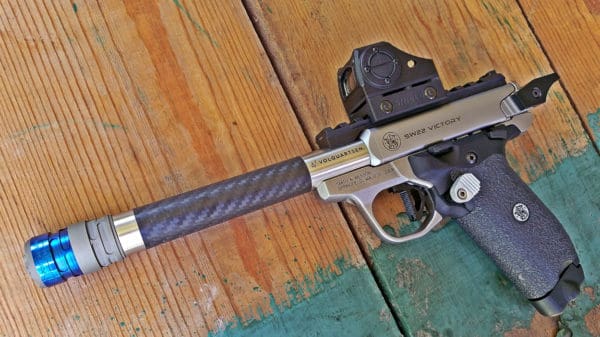

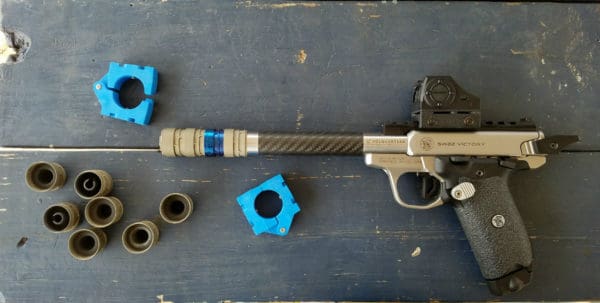

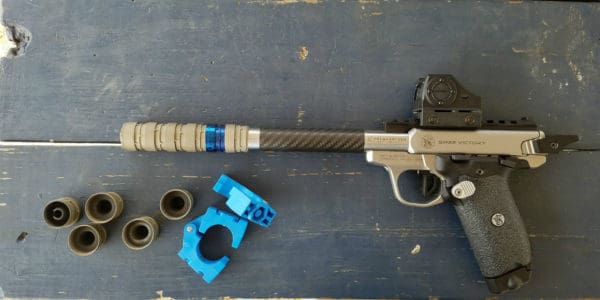

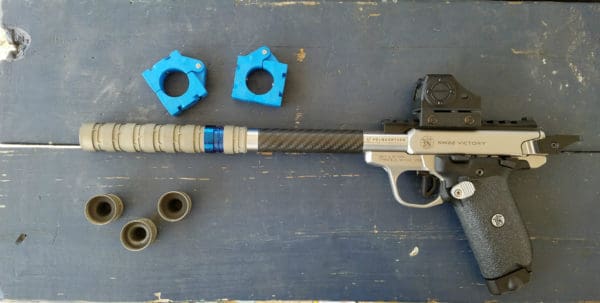
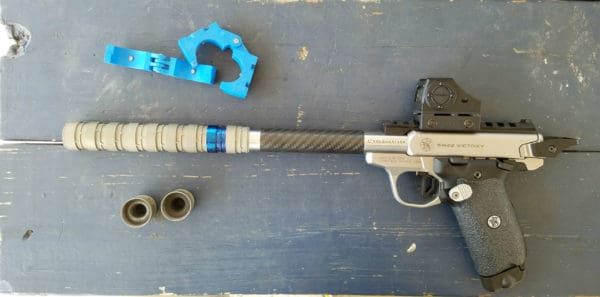


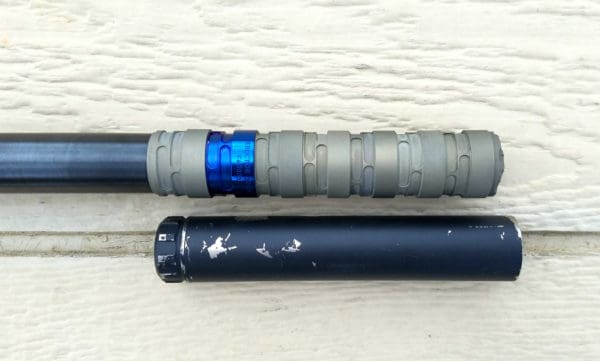
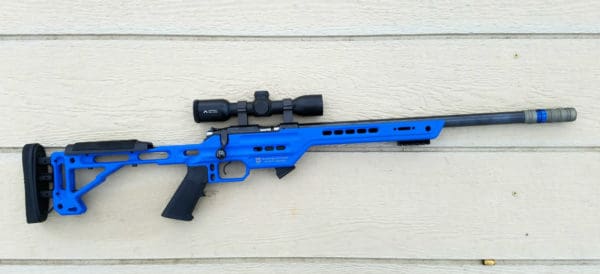
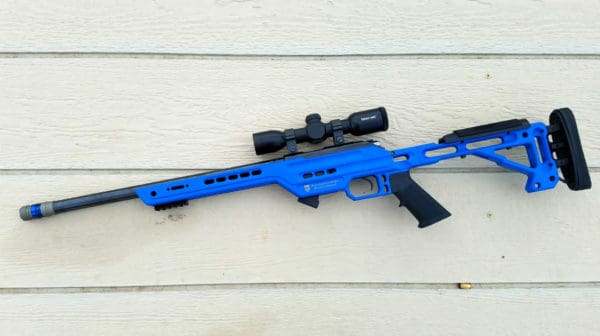
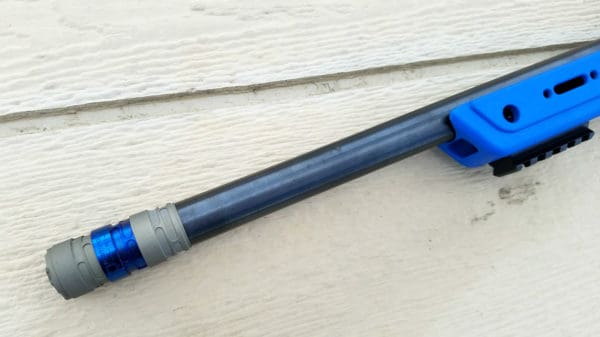
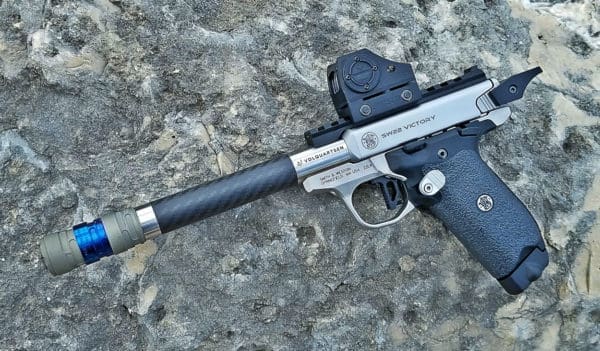
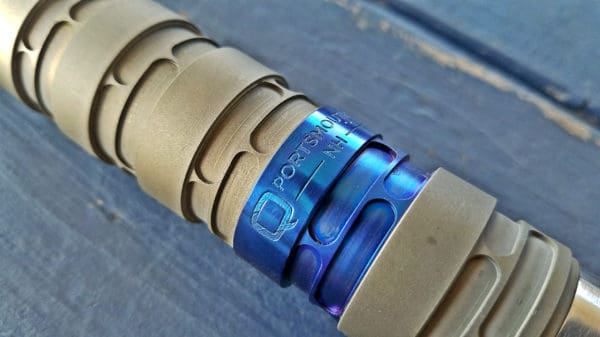
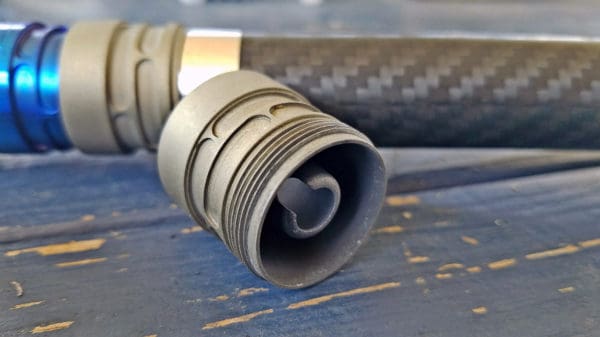



Hmmm….may have to re-think if I want a can now.
FYI, word on the street (and from places like Silencer Shop) is that the NFA branch is closer to caught up on Form 4 applications than ever, the volume of applications has been low, and one submitted right now is expected to only take ~3 months to approval. Basically, people expect it would currently be the fastest it has been in many many years. Also, because suppressor sales have been so low for the past 12 months, prices are the lowest they’ve been in many years with the most aggressive sales we’ve seen in many years. So, all considered, a very good time to buy.
Unfortunately, suppressors are not legal in the Garden State (NJ), and probably never will be..??
I beg to differ Jeremy. I’m still waiting on one submitted back in January. (Another from May, but not going to expect that one this year.)
NFA tracker is currently showing about 7-9 months.
3 months? I’d buy a Q tonight if it was 3 months.
3 months from now is quite a bit different than 3 months from Jan. I’ve got one more form 4 from just before the 41f change that I’m waiting on (I had a couple dozen go in within the 2 weeks before it changed). I’m expecting the wait times to drop significantly once they’re through with that stuff.
That’s assuming that they continue to staff the NFA branch at a “reasonable” level.
Yeah, I hear ya Tom and it’s a weird freakin’ system, but they’re saying that even though wait times were expected to be 9 months 2 months ago, an application today they’re thinking will take like 3 months. (Silencer Shop owns / is NFA Tracker, BTW)
See, that’s like common core math. I simply don’t understand it.
And Jack. Dates man, dates. 41f means nothing to me. When did you file, and when did you own it in your hands.
Tom,
I’m a SOT(small time). Without looking at my books, I had approx 2 dozen submissions between 1 and 12 Jul 2016. All of those are back except one. Based on my sales before the change (13 Jul 2016), and after, I’m expecting times to drop significantly.
For those guys that bought end of 2016 and are still waiting… They are still waiting on the ATF to get through all the applications from pre 41f.
Guys that buy now, should have much less wait time because they’re almost through the glut of applications from before the change. Because the amount of applications, post change, has dropped dramatically, it should significantly reduce the wait times.
Yeah, I’m shopping hard for a rimfire suppressor right now.
Not for me! For 99% of the people that buy this it would stay in the full length configuration 99% of the time. Changing length would change the POI of the bullet. Also once this gets gunked up (technical term) it will be very difficult to unscrew the baffles. There are a lot of other 22 options that are a better value. Although I guess more choices are always better…even if they are not.
I dunno, full length is a bit long and it sounded just as quiet to me in the more typical ~5″ to 5.75″ length range. But that was outdoors, where it isn’t unusual for a .22 LR to meter higher at the muzzle but not really change at the shooter’s ear or not enough to notice. Whereas if you shoot indoors or near objects and such, the noise from the muzzle reflects back and you really hear it. Anyway, changing the length to change the suppression level is legitimate enough that I think people would actually do it. I’d definitely do it going back and forth between pistol and rifle for sure. …and on my bull barrel 16″ rifle I really don’t think going from a 1.3 oz can to a 2 oz can would change POI enough to care about.
I should have also mentioned in the review that the baffles seal together pretty dang well, with the lip below the threads of one sealing against the flat inside baffle face of the next. Basically, the threads stay surprisingly clean as they’re purposefully sealed off from combustion gases and such. If you expand that 4th photograph to full size, you can see how the flange under the mail threaded end seals onto a shelf inside of the female threaded end and, while there is obviously some carbon that made its way to the threads, it’s mostly bare metal whereas inside of that female side of the baffle is completely jet black and caked with a solid layer of carbon.
But yeah, as mentioned above, I think the Erector would be a really cool 2nd or subsequent rimfire can to buy but isn’t likely to be the most reasonable first one (where I’d much sooner suggest something in the format of Q’s El Camino — titanium tube with stainless baffle stack that seals the inside of the tube off from getting dirty. Lightweight, fixed length, no real frills but rated for lots of calibers).
Help Please!
Buy the El Camino now or wait for the titanium version?
Because of stupid state law, I intend to silver-solder the can to a Mk. IV 22/45, so I am looking for a great pistol can that won’t change the gun’s balance too much.
Also – Any idea when the titanium El Camino will be released ?
No threaded barrels allowed in CT, and no exclusion for rimfire? If that’s the case, instead of welding your suppressor to your barrel how about turning the threads into a tri-lug? Weld that to your barrel instead. Now you can use whatever rimfire suppressor you darn well please and remove it and put it back on as much as you want and use it on as many guns as you want to since you can buy more of the tri-lug barrel side parts separately (link here)
That said, I hadn’t heard of any plans for an all-titanium El Camino. As it’s made now, the body is titanium and the baffles are stainless. It’s a 4.3 ounce can, which ain’t bad at all.
Correct – Right now I have a thread cover soldered in place.
I’ve thought about the tri-lug thing. Only issue is I don’t want to increase the gun length even more. Anyway, I still have some time to think about it, as I have yet to order the can.
The post below from SilencerShop from October references a 2.2 oz all-titanium version of the El Camino. I
https://www.facebook.com/SilencerShop/videos/1436156506405126/
Yes – In CT rimfire long guns can have one extra “evil feature” but not pistols. I have thought about the Gemtech mount, but don’t really want to add extra length.
Post from SilencerShop regarding an titanium-baffled El Camino – supposed to be 2.2 oz
https://www.facebook.com/SilencerShop/videos/1436156506405126/
I pinged Q and they said the all-Ti El Camino was something they considered but will not be making. (I’d be pretty darn shocked if it ended up being that light, though. My guess would put it at like 2.8 ounces IF the baffles were dimensionally *identical* to the stainless steel ones and I bet they’d actually be a little thicker)
You should fly down to Austin. We’ll go shoot a dozen different .22 LR cans of various lengths and weights and try out the GEMTECH 3-Lug mount. Honestly, with your restriction on having a threaded barrel I really think that mount is the way to go. Or, search for a .22 LR can where the mount isn’t considered a legally-restricted suppressor part and weld the mount onto various guns so you can unscrew the can from one and move it to another. Otherwise, why even buy a separate suppressor? Just get an integrally-suppressed setup. The whole welding thing seems like a PITA that won’t be as clean and won’t look as good and will still lock you into a fixed setup just like an integral setup would. There are plenty of 22/45 “uppers” (which, yeah, are the registered firearm part) that are integrally suppressed and look badass.
@Jeremy – Thanks for checking with them. I’m going to order the current El Camino, and have also ordered the GemTech adapter. I’ll take that and the Mk IV barrel to my local smith and see what he thinks about attaching them (after he un-solders the thread protector currently keeping the pistol legal). And then of course I have to wait to get the grip module back from Ruger.
I will be down in Texas for the Firearms Festival, this fall. Missed it last year, but made it the year before.
I think that CT and MD are the only states with AWBs where Silencers are legal (and MD has a looser AWB.
” I intend to silver-solder the can to a Mk. IV 22/45…”
Is it even possible to silver solder or weld – fuse the aluminum mount to stainless or carbon steel?
TIG perhaps?
I have had some luck with silver soldering stainless to stainless (some alloys easier than others, some not at all)…
You can silver solder Titanium to carbon steel. I don’t think there’s a decent way to weld those together and aluminum is a whole ‘nother beast. I think in his scenario though it would be Ti to steel.
Certainly you could drill through the suppressor mount and into the threads of the barrel and slightly but not all the way through the barrel, insert a Ti (or aluminum, if the suppressor mount is aluminum) pin, and then weld the top of the pin to the suppressor mount. That should still meet the legal requirement of “permanently attached” without actually having to weld different metals together.
How are these not extra silencer parts like the no-no of having extra baffles? Cool concept, though! I like it.
There is a way to get an exemption for certain parts like end caps, mounts, etc. Or, maybe they are considered silencer parts and therefore repairing/replacing/modifying them yourself wouldn’t be legal, but reconfiguring them is fine. After all, disassembling and cleaning has always been okay for end users. I don’t think it’s illegal to reassemble something “incorrectly” or in a different manner than the manufacturer shipped it? Maybe. Don’t quote me! 😉
Yeah, they should make a 35 baffle option so you will have spares.
Sadly, Q is absolutely booking for an (undeserved) ATF clarification with these. ATF has (finally) cleared up where the serial must go, and it is the ‘tube.’ Each of these interchangeable cups is a ‘tube’ as far as silencer anatomy, ergo the ATF will inevitably rule that as a box of 9 suppressors that can attach end-to end. I think the ATF tolerated the other modular designs because their ‘extra’ parts couldn’t really be used anywhere else (you could at most swap the modular part with another modular part on a second silencer). Q’s solution is a true LEGO build, where parts can be shuffled around between any number of barrel/thread adapters to make different numbers of silencers of different lengths; that inability to ‘keep tabs’ on the silencer configuration is likely to irk the ATF enough to take action. For Pete’s sake, they just locked down rubber wipes for essentially the same justification (“the only reason these are removable/replaceable is so you can swap them out with extras when they wear, and we don’t like the idea of extra silencer parts since they magically constitute complete silencers but only while separate from the silencer assembly)
It’s just too easy to tell a congressman/president that Q is evading 8 tax payments of 200$ for each of these units the ship.
I do applaud them for raising the following questions:
-How many removable chunks before they become ‘extra’ (i.e. ship a unit with fifty baffles & claim none are spares)
-How long before a baffle becomes its own silencer (i.e. make a version with 6” long segments) & requires serializing
-If I have more silencers than barrels they may attach to, and they can hook together to form single giant silencer, can I create/transfer them as such under a single tax stamp payment?
The baffles, whether individual or connected together, are worthless without a way to mount them to the gun. There is but one mount here, and it’s the serialized part. Meaning, there is but one suppressor.
Isn’t that the logic behind the oil filter adapters?
The oil filter adapter itself is serialized, and the filter itself is stamped as well.
Blow out the filter, you have to ship it back to Cadez for them to stamp a new one. I don’t know for sure, but they may amend their manufacture record to record the change…
I think that pretty much applies here, too. It’s unlikely that you’d legally be able to replace or repair one of these baffles yourself. If you damaged one, I assume you’d have to send the suppressor in to Q (or another SOT) for replacement. However, disassembling and reassembling are fine, just like you could separate your oil filter from the mount part if you wanted to.
It’s fairly typical for suppressor manufacturers to serialize the part that’s least likely to be damaged. That way, the other pieces can be replaced without it counting as being a new suppressor. If the serialized part has to be replaced, it’s a new can and you have to do the entire Form 4 process all over again, including a new tax stamp, etc. If the manufacturer wants to do swappable mounts, though (different mounts that the end user can swap for different thread pitches and such), then the mount can’t be serialized and they’ll usually do the tube. If the mount is sort of the root/core part of the suppressor (like the oil filter example, like the Erector here) and the most durable piece, then it’s a good choice for the serialized part.
“Stab an EpiPen into the torpid evolution of silencers (and even firearms) and skip a few generations.”
Considering a nice can costs as much as two EpiPen prescription…
Actually, an EpiPen brand EpiPen runs about $600!… (http://www.reuters.com/article/us-health-epipen-costs-idUSKBN16Y24O
In its single-baffle configuration, it makes that S&W Victory look a little like a Star Wars blaster pistol. So cool.
Not to get too off-topic. But when are you going to review that rifle chassis?
Working on it! It’s here on loan for review from MPA. That’s my CZ 455 that it’s on.
Jeremy, if the aluminum is as thin as you claim on the parts, you should be cautious about dumping the parts in a cleaning solution overnight to ‘loosen up’ the crud stuck on it.
Some of those cleaning solutions are rather high in Ph, meaning basic, and that could thin the already thin metal to the point of perforating it…
Yeah, that’s one of the things I was alluding to when mentioning that there are various cleaning restrictions related to aluminum baffles. The downsides to the crazy light weight here are, mainly, caliber and cleaning restrictions.
How long till the ATF says you need a stamp for each segment?
Right until some ATF prosecutor realizes he can try for nine counts of possession vs. one…or some dood tries to claim his three illegal cans bolt together and should only count as a single charge against him 😉
Really, no comments on how ugly this thing is? All those sharp machined aluminum corners & bead-blasted faces are gonna look pretty crummy after some use and a few cranks with the spanner wrench. I’m not sure why companies still insist on making the polar opposite of smooth, sturdy, organic designs in an age where machining is so inexpensive.
Excellent thorough review of a cutting-edge piece of firearms technology. Thanks, Jeremy. I believe this product pushes silencer technology forward. Light weight is important, and at the end of the muzzle more than anywhere else! With the modular design offering quick adjustability from “muzzle device” to “porn star” and back, there are few practical reasons to ever shoot without this suppressor once purchased. I appreciate the detail in this review, such as the gallery of different configurations. I haven’t seen such an effective pictorial guide to lengthening an erection on TTAG since Farago ceased posting Israeli supermodel cheesecake.